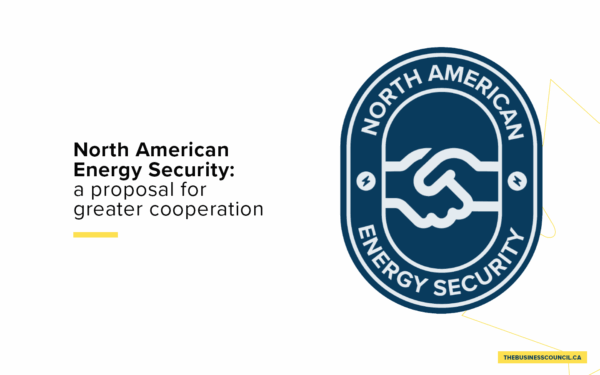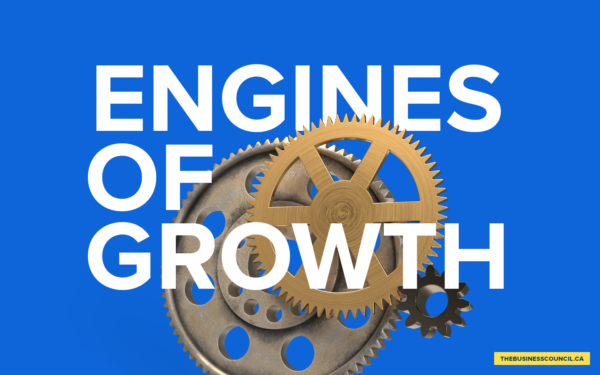Annual Report 2015/2016
Building the future
About the Council
Founded in 1976, the Business Council of Canada is the senior voice of Canada’s business community, representing 150 chief executives and leading entrepreneurs in all sectors and regions of the country. Member companies employ 1.4 million Canadians, account for more than half the value of the Toronto Stock Exchange, contribute the largest share of federal corporate taxes, and are responsible for most of Canada’s exports, corporate philanthropy, and private-sector investments in research and development. Through supply chain partnerships, service contracts and mentoring programs, Business Council members support many hundreds of thousands of small businesses and entrepreneurs in communities of all sizes across Canada.

Message from the Chair
When he arrived in Canada in the late 1950s, my father was a refugee from communist Hungary with little in his pockets but plenty in the way of skills and ambition. Trained as a machinist, he started a one-man precision-machining shop in his basement and built it into a diversified manufacturing company – Linamar Corporation – with 57 plants across the world employing more than 24,000 people.

For Frank Hasenfratz, and for many other people who made their way to Canada in the postwar period, this country was a land of opportunity. Is it still one today? Without hesitation, my answer is yes. Of course we have our challenges – who doesn’t? But even with all the advances in the global economy over the past half century, Canada is still among the best places in the world in which to start and grow a business.
Consider the facts:
- International studies rank Canada one of the best-governed jurisdictions in the world, with strong public sector institutions, a transparent legal system, and low levels of violence and political corruption. Canadians often take these things for granted, but few things matter more in business than a stable political environment and the rule of law.
- Canada’s comparatively open immigration system attracts a diverse pool of educated and skilled workers, not to mention hundreds of thousands of international students who come here for our world-class universities, polytechnics and colleges. Our immigration policies are a vital source of ambitious entrepreneurs. Immigration also helps fill gaps in Canada’s domestic labour force – a critical success factor for companies that face skill shortages in high-demand fields.
- Corporate tax rates are lower in Canada than in the United States and many other jurisdictions. Although there has been some backsliding recently at the provincial level, our governments deserve full marks for recognizing that a globally competitive corporate tax regime is essential in attracting and retaining business investment.
- According to the OECD, the tax burden on labour in Canada – the difference between an employer’s cost of labour and the employee’s take-home pay – is significantly below the average for the world’s leading economies. My own company’s experience attests to that: our burden rate in Canada, including payroll taxes, health insurance and other non-statutory benefits, is the lowest of any of the 11 countries we operate in.
- The federal government’s ambitious trade strategy ensures that Canadian companies enjoy – or will soon enjoy – preferred access to many of the world’s largest and most dynamic markets. Bigger markets to buy from and sell to mean more opportunities for Canadian firms to grow and become more efficient. That’s why it is crucial to ratify and implement both the Canada-EU trade deal and the Trans Pacific Partnership.
- Canada has a long history as an innovation nation and a strong tradition of public sector support for research and development. In today’s competitive and interconnected world, this is an area where we can’t afford to take our eyes off the ball. The federal government’s renewed focus on innovation as a driver of opportunity is a move in the right direction. So too was this year’s launch of the Governor General’s Innovation Awards, celebrating entrepreneurial risk-takers who have developed new or better ways of creating value and improving our quality of life.
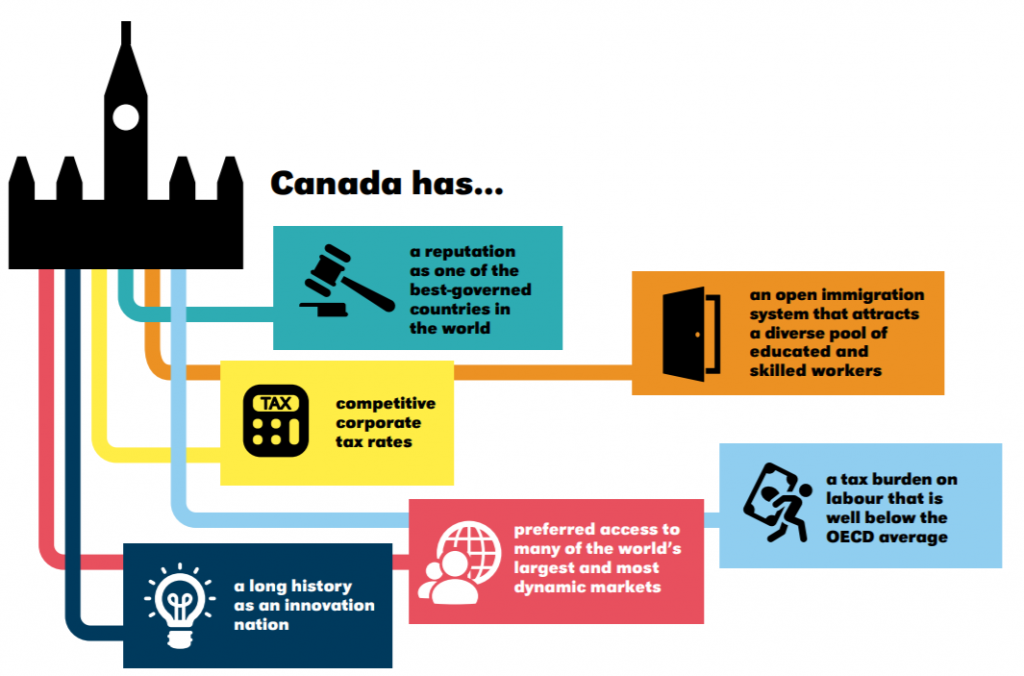
As a business leader, it frustrates me to hear people suggest that Canadian manufacturing is no longer competitive. At Linamar, our Canadian plants are our most productive and efficient globally. We have dramatically increased our productivity over the past five years and we are far from alone. Our commitment to innovation is widely shared, too, as shown by the collection of success stories in this edition of our Annual Report (page 12).
Our focus at the Council over the next few years is on precisely this topic:
innovation. How can we encourage even more meaningful innovation in both process and product development to secure Canada’s place on the global map? Innovation and efficiency define our competitiveness: investment in both is critical. Our goal should be to position Canada as the world’s innovation hub, with the best engineers, technologists and skilled tradespeople developing incredible products made with the most efficient processes.
A land of opportunity? Canada has it in abundance, thanks to smart public policy, a culture of entrepreneurship and a high-quality, skilled labour force. Together with my colleagues at the Business Council, I look forward to working with other decision-makers in all regions and sectors in building a stronger, more prosperous Canada.
Linda S. Hasenfratz, Chair

Message from the President and CEO
News from north of the 49th parallel doesn’t often dominate the front page of The New York Times, but the headline this past July 1st was hard to miss: “Refugees hear a foreign word: welcome”. The accompanying story and photo essay explained that Canada’s laws give its citizens a rare power and responsibility: the right to band together in small groups and personally help resettle a refugee family. “Much of the world is reacting to the [Syrian] refugee crisis … with hesitation or hostility,” the Times said. In contrast, “the Canadian government can barely keep up with the demand to welcome them.”

Is Canada really all that different from other countries in terms of its openness toward asylum-seekers and other migrants? After a video showing Prime Minister Justin Trudeau sharing a Ramadan meal with Muslim caucus members went viral on Facebook, the digital news site Vox praised Canada as “the least xenophobic country in the Western world”. The article juxtaposed Canada’s acceptance of 25,000 desperate Syrians with the anti-foreigner backlash that helped fuel the “Brexit” vote against U.K. membership in the European Union.
Sadly, xenophobia and isolationism are on the rise in many regions around the world. Whatever the outcome of this fall’s U.S. presidential election, Donald Trump plainly struck a chord with many Americans with his vows to build a wall along the Mexican border, deport 11 million undocumented migrants and ban Muslims from entering the country. The World Economic Forum, meanwhile, says that terrorist attacks and a massive surge of refugees from the Middle East and North Africa have driven migration-related worries to “unprecedented levels” in France and Germany. The rising wave of anti-immigrant sentiment across Europe, the Forum warned, could trigger a rollback of the EU’s cherished system of passport-free travel.
Canadians shouldn’t feel too smug about our country’s reputation for multicultural tolerance and diversity. As a share of total population, no other country welcomes as many immigrants as we do, from as many different places. But unlike, say, Germany – which in 2015 accepted almost one million asylum-seekers, half from Syria – Canada is buffered by oceans to the east, west and north, and a prosperous neighbour to the south. As a result, illegal immigration and fear of uncontrolled borders barely register in Canada as public concerns. Rather than being forced to contend with huge waves of uninvited migrants, our governments can pick and choose
applicants based on criteria such as their level of education and potential ability to contribute to the economy.
Still, those factors alone don’t fully explain Canadians’ positive attitudes toward immigration and diversity. Irene Bloemraad, a sociologist at the University of California at Berkeley, says it is striking that a significant percentage of ordinary Canadians view immigration as both an exercise in nation-building and a key positive feature of their country. In much of the rest of the world, people who express high levels of nationalism and patriotism tend to hold anti-immigrant views. In this country it is the reverse: surveys show that Canadians who express high levels of patriotism are also the most supportive of immigration and multiculturalism.
Bloemraad has coined a term for this way of thinking: “Canadian exceptionalism”. Although Canadians aren’t immune from anti-minority sentiments, most see immigration as beneficial to our economic future and believe the primary role of immigration policy is to help new arrivals find jobs and integrate into society, rather than instilling cultural norms and values.
Perhaps that explains why Canadian politicians who pander to fears based on ethnic and religious differences – as occurred in both the 2015 federal election campaign and the 2014 provincial election in Quebec – are generally defeated at the ballot box. Intolerance may be a winning, and increasingly popular, strategy in many other countries, but Canadians play by different rules – and thank goodness for that.
The Honourable John Manley,
P.C., O.C., President and CEO


Year in Review
Economic and fiscal policy
In challenging economic times, calls for fiscal stimulus to kick-start growth need to be weighed against the long-term negative consequences of higher government debt. The Business Council has urged governments across Canada to maintain a strong focus on fiscal discipline, and to look at all requests for new spending through a competitiveness lens. In a February 2016 letter to Finance Minister Bill Morneau, the Council laid out a number of steps that the new government could take to strengthen Canadian competitiveness over the long term.
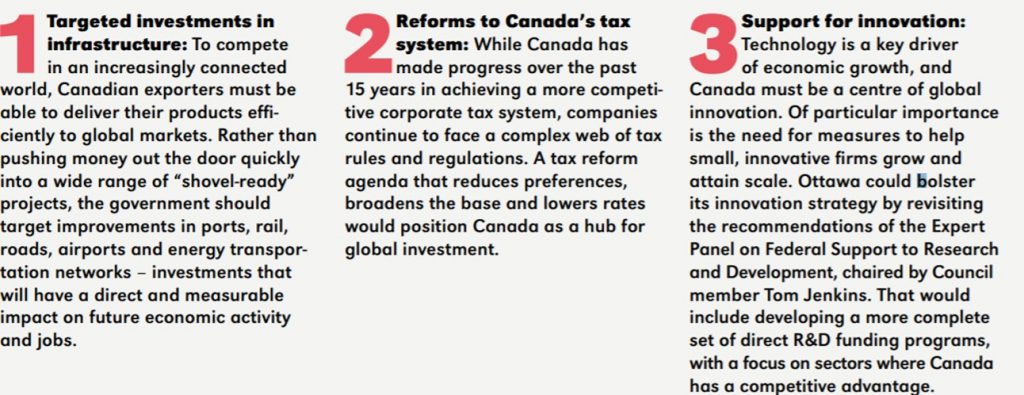
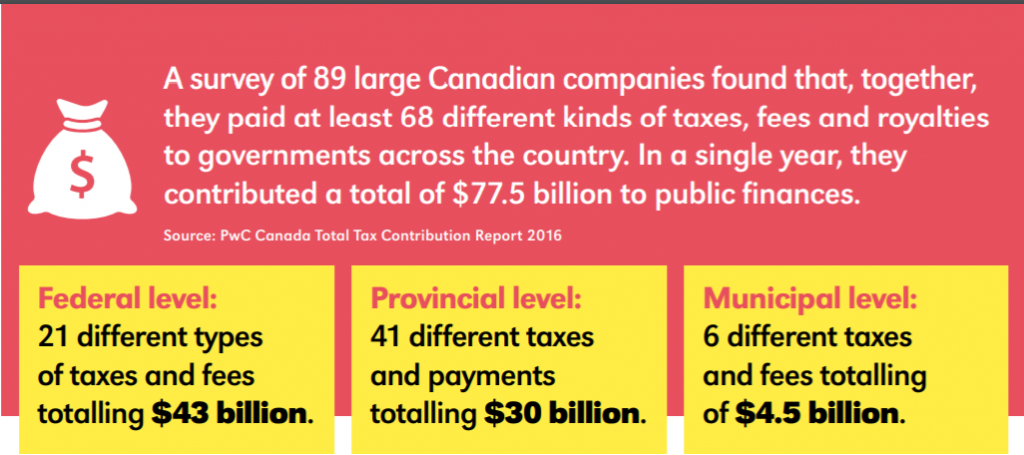
Trade and investment
The past year underscored not only the importance of trade to the Canadian economy, but the benefits of sectoral and geographic trade diversification. Although the global drop in oil prices created serious challenges for Canada’s energy sector, exports rose significantly in a number of other areas, including advanced manufacturing, agriculture, forestry and the auto sector. Meanwhile, representatives of Canada and 11 other Pacific Rim countries wrapped up seven years of negotiations on the Trans-Pacific Partnership (TPP) – an agreement that, if ratified, would provide important new opportunities for Canadian exporters in a $28 trillion market with nearly 800 million customers.

For Canada, the TPP represents a breakthrough on several levels. For the first time, Canadian exporters would gain preferred access to markets such as Japan, Australia, Vietnam, Malaysia, New Zealand and Singapore. The TPP also builds on the North American Free Trade Agreement, through which Canadian exporters enjoy preferential access to customers in the United States and Mexico.
In addition to pushing for ratification of the TPP, the Business Council continues to advocate on behalf of the Comprehensive Economic and
Trade Agreement (CETA) between Canada and the European Union (EU). Particularly in light of the June 2016 “Brexit” referendum result in the UK, European leaders need to demonstrate that they retain the capacity and the resolve to move forward with a major international agreement. Together with its counterparts in the European business community, the Council intends to redouble its efforts to ensure implementation of CETA at the earliest opportunity.
North America
Canada and the United States share the world’s largest and most comprehensive trading relationship, supporting millions of jobs in each country. Together with Mexico, they form a North American platform for economic growth and social development. As global competition intensifies, these partnerships will become even more important.
On June 29, 2016, Prime Minister Justin Trudeau welcomed U.S. President Barack Obama and Mexico’s President Enrique Peña Nieto to Ottawa – the first time since 2007 that Canada has hosted a North American summit. The Business Council congratulated the three leaders for their efforts to streamline cross-border commerce, and for speaking out about the costs of protectionism.
Over the past year, the Council has welcomed closer North American cooperation on a number of important issues, including:
- Energy. Canada, the United States and Mexico trade $167 billion in energy products across the continent annually. By mapping trilateral energy trade, monitoring infrastructure, and sharing data, the three countries are working to create a stronger and more stable North American energy environment. Looking forward, the Council urges all partners to streamline their approval processes for cross-border energy infrastructure.
- Climate change. Canada currently obtains close to 80 per cent of its electricity from clean sources, including hydro, nuclear, wind and solar. The United States and Mexico rely much more heavily on carbon-based sources, but both have pledged to significantly increase clean energy production by 2025.
- Cross-border travel. In late 2016, Canada will lift the visa requirement for Mexican visitors – a significant irritant in bilateral relations since it was imposed in 2009. In addition, Canadian and U.S. citizens who hold NEXUS trusted-traveller cards will be able to apply for the Mexican equivalent, providing them with expedited entry into that country.

Energy and the environment

Sustainable environmental policies go hand-in-hand with long-term prosperity. Even as oil prices remain supressed, the world’s demand for energy continues to grow. The Business Council is strongly committed to making Canada a global leader in sustainable development, demonstrating that healthy economic growth, high living standards and environmental protection can be mutually supportive.
In that pursuit, the Council has long championed the development of a pan-Canadian vision for the country’s energy future. In 2015, the Premiers formally endorsed the Canadian Energy Strategy. Now that the federal government has offered its support, a key test will be whether individual provinces can move beyond a narrow focus on their own political interests and energy strengths, and advocate for the national interest in energy development.
In 2007, the Council became the first business organization in Canada to call for a price on carbon. By 2017, carbon-pricing programs will be up and running in provinces accounting for more than three-quarters of the country’s GDP and greenhouse gas emissions. While the Council would prefer to see a more consistent national approach, Canadian businesses are anxious to get on with the job of improving energy efficiency and adopting technologies that will improve their economic and environmental performance.
Corporate and public governance
Good corporate citizenship at home and abroad – which includes respect for human rights, environmental stewardship and community investment – plays an essential role in enhancing public trust, attracting and retaining talent, and reducing investor perceptions of risk.
The Business Council has been active in supporting the efforts of securities authorities to promote sound corporate governance. During the drafting of the Canadian Securities Administrators’ proposal on “whistleblowers”, the Council highlighted the fact that most publicly traded corporations already have in place rigorous internal reporting and compliance systems to identify potential problems and take corrective action. The Council further took the position that employees who become aware of cases involving securities-related misconduct should be required to report internally, before they can qualify for any whistleblower reward. Moreover, employees who are themselves complicit in the violation of securities laws should not be eligible for such rewards.
Throughout the year, the Council monitored and responded to ongoing legislative and policy developments, including “say-on-pay” initiatives, shareholder rights, proxy access and transparency issues related to payments to foreign governments.
Also during 2016, the Council advised the federal government on policy changes to ensure the integrity of government suppliers and deter corrupt practices. This included urging the government to follow the lead of the United States and the United Kingdom in adopting deferred prosecution agreements (DPAs) as an additional compliance tool. DPAs increase the incentives for companies to self-report wrongdoing and to cooperate with the authorities during an investigation, while at the same time reducing the possibility of harm to innocent employees and shareholders who played no part in the transgression.
Innovation and competitiveness

To succeed in a highly competitive global marketplace, Canada needs an economic policy framework that fosters entrepreneurship and promotes innovation. Innovation occurs not just through the creation of new technologies, but through the development of transformative processes, products and partnerships that create new value or make possible new business models. Competition is a key driver of innovation, since it forces companies to adopt more efficient production processes. At the same time, companies need scale to be able to compete internationally. For that reason, the Council has encouraged governments to adopt policies that reward innovative companies that have the capacity to grow, create jobs and become global champions from a Canadian base.
Digital technology has delivered countless benefits to consumers and businesses, but it also leaves them vulnerable to a wide range of cyber crimes, from fraud to online terrorism. In early 2016, the Council and a group of leading Canadian companies launched the Canadian Cyber Threat Exchange (CCTX), an independent, not-for-profit organization that works to safeguard Canadians by collecting and sharing accurate, up-to-date information about cyber threats and vulnerabilities.


Jobs and skills
Canada has always been a leader in providing its citizens with high-quality public education, but the world is changing and we need to aim even higher. Around the globe, countries that were once poor and low-skilled are making unprecedented investments in education and training. The international talent pool has never been larger – and its growth rate has never been faster.

Over the past year, the Business Council has sought to build support for policies and programs that would better prepare young Canadians for the 21st century labour market, while at the same time ensuring that Canadian companies have access to the talent and skills they need to succeed in a competitive global economy. In a report published by the Council in June 2016, economists Don Drummond and Cliff Halliwell called for greater collaboration among governments, business and educators to provide Canadians with more accurate and timely information about hiring trends and the state of the labour market. Separately, the Council recommended updates to the Temporary Foreign Worker program and a more coordinated approach to the recognition of foreign credentials.
In partnership with Aon Hewitt, the Council asked 90 of Canada’s leading employers about their current and future skill needs. The survey revealed that large companies are increasingly looking to recruit and develop employees who demonstrate strong “people skills” and can adapt to changing workplace and industry circumstances.
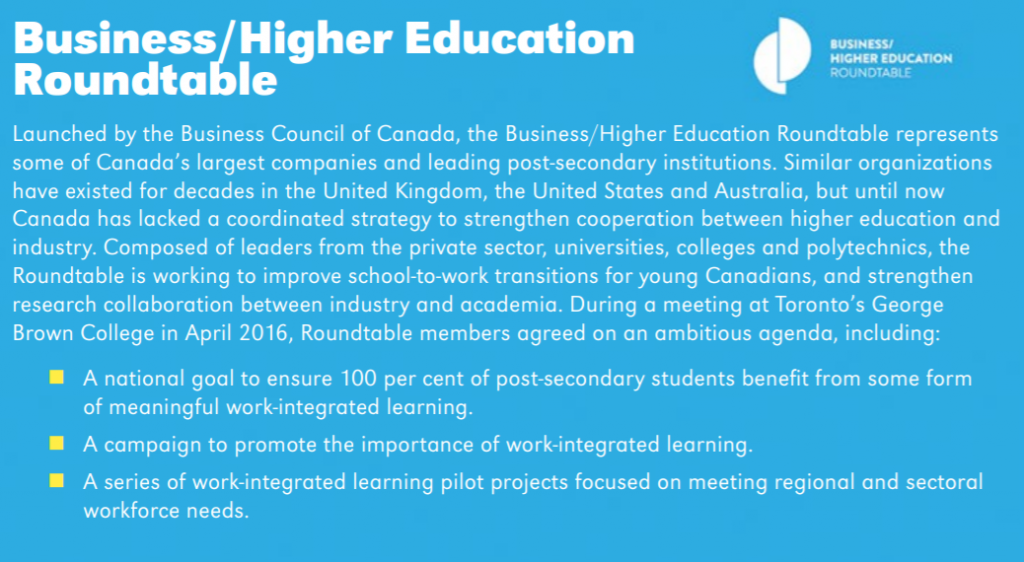

Building the Future
Canadian innovations have shaped the world around us, from kerosene (1846) to insulin (1922) to canola oil (1970s) to the world’s first commercially available quantum computer (2011). Today, Canadian companies continue to innovate, solving challenges and seize business opportunities by developing new products, devising creative processes and building broad research partnerships. Some recent examples of innovation from member companies of the Business Council:

Driving innovation

The automotive industry has been a source of engineering breakthroughs for well over a century, but never more so than today as manufacturers strive to meet ever-rising fuel-efficiency and emissions targets. Linamar, a leading provider of precision metallic components and systems, is playing a part by designing, testing and prototyping a wide variety of next-generation powertrain systems. In 2003, Linamar purchased Detroit-based McLaren
Engineering, founded by car racing legend Bruce McLaren. Since then, Linamar’s McLaren Performance Technologies group has carved out a niche as a supplier of complex and highly technical components for advanced all-wheel drive systems, electric hybrid power units and other innovative solutions. In the company’s own words, “The integration of a lean-focused manufacturing operation with that of a racing-inspired engine development service provider has proven to be an industry-leading combination.”
Innovation labs
Sometimes the best way to help people think outside the box is to encourage them to leave the office. A growing number of Canada’s leading companies are doing just that: setting up remote research and development teams and empowering them to explore new business models and disruptive technologies. These so-called innovation labs allow companies to test-drive ideas before scaling them up across the enterprise. They can also serve as incubators for start-ups whose business plans align with the growth strategy of the parent company. Companies often build their labs across the street from one another or within the same building, creating an ecosystem ripe for brainstorming, testing and cross-collaboration. Examples:

Banking on change
Opened in 2014 by TD Bank Group, TD Lab describes itself as an “innovation workspace exploring emerging tech and legendary customer experiences”. It does that by challenging employees to think differently about their customers’ needs and the ways in which digital technology can better serve them. So far, the bank has collected close to 10,000 ideas, built 25 proof-of-concepts and prototypes and worked with more 50 start-ups. One solution that has already been rolled out for testing is a smartphone app called Family Allowance, geared towards teaching kids how to save and budget their money.

Crunch time
d { }, which is pronounced “dee space”, is a software/hardware prototyping lab created by Deloitte within the Communitech innovation hub in Kitchener-Waterloo, Ontario. Its mission is to bring to life new ideas and technical solutions that will solve complex business problems, uncover new technology-based business opportunities, and enable Deloitte to better serve its Canadian and international clients. To that end, the designers and developers who work in d { } are leveraging a wide range of emerging technologies such as 3D printing, wearables, biometric authentication, and the Internet of things.

Ensure success
Manulife Financial’s RED Lab focuses on inventing and testing new financial services solutions and driving a more innovative culture within the parent company. Manulife recruited the lab’s first employees exclusively from outside the company, so RED staff could approach every issue from a fresh perspective. “Literally, RED stands for Research, Exploration and Development,” says Rocky Jain, the lab’s director. “Symbolically, the colour red, which sits opposite green on the colour wheel, represents an entirely different way of thinking at Manulife.”
Watch out
CIBC’s corporate innovation hub, located in the Financial Technology (FinTech) cluster of Toronto’s MaRS Discovery District, has already made its mark by developing the company’s first app for the Apple Watch. With business and technology teams working side-by-side, the project moved rapidly from idea to prototype to implementation. CIBC was the founding partner of the MaRS FinTech cluster, which is designed to connect the city’s established financial services players with startups developing next-generation technology in emerging payments, peer-to-peer transactions, alternative lending and crypto-currencies.
Moving digital
The retail industry has changed dramatically since the dawn of the Internet age, but even bigger changes are now in store. In Canada, leading merchandisers such as Canadian Tire are embracing digital disruption and
rethinking how they do business from the ground up. In May 2015, the iconic retailer opened the doors to its newest innovation centre, the 3,200 square-foot Digital Garage in downtown Kitchener, Ontario. The facility, together with Canadian Tire’s Cloud Nine Digital Innovation Centre in Winnipeg and similar groups in Toronto, Calgary and Montreal, is geared to developing new in-store and online technologies that improve efficiency and boost customer satisfaction. The company’s three-year innovation strategy encompasses changes to marketing, internal logistics, supply-chain tracking, cloud-based data storage and e-commerce platforms.
Underground secrets
Two kilometers beneath Sudbury, Ontario, a world-class team of physicists is helping to unlock the secrets of the universe. SNOLAB, the second-deepest underground research facility in the world, operates within Vale Canada’s working Creighton nickel mine. Because of its depth, the facility benefits from extremely low levels of dust, cosmic rays and background radiation – conditions that make it an ideal setting for research focused on sub-atomic physics. (SNOLAB stands for Sudbury Neutrino Observatory Laboratory.) In 2015, the Royal Swedish Academy of Sciences awarded Queen’s University scientist Dr. Arthur McDonald the Nobel Prize in physics for his neutrino
research at SNOLAB.

Saving lives
Human patient simulators are widely used in medical education, but until recently there was a gap in the marketplace – a gap the size of half of the world’s population. Other than specific models designed for pregnancy and child-birthing simulations, all of the most advanced and realistic patient simulators were based on the male body and incorporated characteristics such as an average man’s heart rate, blood pressure and lung capacity. Recognizing the need to train doctors, nurses and first-responders on women’s physiology, CAE recently launched Athena, the world’s most advanced, anatomically correct female patient simulator. Athena incorporates state-of-the-art technology that accurately mimics various medical conditions and responds automatically to clinical interventions – elevating experiential learning to a new level of realism.
Heavy lifting, big progress
A revolutionary new software suite developed by PCL Constructors Ltd. in collaboration with academics from the University of Alberta is paying huge dividends in major infrastructure projects. In the past, it used to take a team of engineers more than a week to work through all the calculations required to devise a safe and efficient plan for lifting heavy pieces of equipment and modules on large industrial plant construction projects. Using its new “HeviLift” software, PCL can now analyse millions of scenarios at a time, taking into account the physical condition of the site, the dimension and weights of various construction modules, a wide range of possible crane configurations and potential rigging modifications. On one recent project, PCL was able to save its client $10 million by developing a 3D visualization model that quickly identified the most efficient approach to conducting on-site crane operations.


Food for thought
Canadians waste an estimated $31 billion worth of food a year, much of which ends up in landfills. In 2015, Loblaw Companies – the largest food retailer in the country – took action against food waste by launching a new line of “Naturally Imperfect” fruits and vegetables. The company takes apples, carrots and other items that are undersized, misshapen or blemished – but still meet rigorous quality standards – and sells them at a discount. Loblaw hopes the initiative will lower the cost of healthy food options for customers, help farmers sell more of their produce and fight food waste.

Smarter power
A multi-year partnership between Siemens Canada, New Brunswick Power and the University of New Brunswick is exploring new ways to provide electricity users with reliable, affordable and environmentally sustainable energy. The project is designed to overcome an inherent shortcoming of traditional electricity grids: they can’t anticipate and respond to surges in demand that can trigger blackouts. The conventional approach to managing peak periods of demand is to build more generating stations, which is expensive and wasteful. In contrast, Siemens and its partners are developing “smart grid” technology that enables communication between customers and their homes, power plants and distribution systems, and shifts energy generation and consumption away from peak periods. New Brunswick’s Smart Grid Innovation Network offers local and global businesses a space to design, develop and test smart grid-related products and services that, once validated in the field, can be implemented in markets around the world.

Into the stars
Innovation isn’t just about creating new products and services – it can also mean devising new ways to share those advances with millions of people around the world. Telesat, one of the world’s largest satellite service operators, has partnered with California-based Space Exploration Technologies Corporation (better known as SpaceX) to launch two satellites – Telstar 18V and 19V – aboard SpaceX Falcon 9 rockets in 2018. Together, the state-of-the-art satellites will provide fast, secure and reliable Internet access to people living in some of the most under-serviced areas of the world, including Canada’s far north, central Asia, and Patagonia.


Growing Together
Large successful companies are essential drivers of a healthy and growing Canadian economy. They employ millions of men and women, pay above-average wages and salaries, contribute billions of dollars in taxes to all three levels of government, and market Canadian products and services to customers around the world.
Of equal importance – if less widely understood – is the crucial role that large firms perform in the broader economic ecosystem by supporting and partnering with countless small and medium-sized enterprises (SMEs). The DEEP Centre, a Waterloo, Ontario-based think tank, surveyed 50 of Canada’s largest companies in 2015 in a bid to shed new light on this mutually beneficial relationship. The study – the first of its kind in Canada – showed that big companies typically act as crucial “anchor customers” for smaller firms. That can include serving as the first client of a promising start-up, providing valuable feedback and introducing the fledgling company to potential new sources of revenue. In so doing, large enterprises help to create environments in which their smaller partners can expand and flourish. Highlights from the DEEP Centre report:
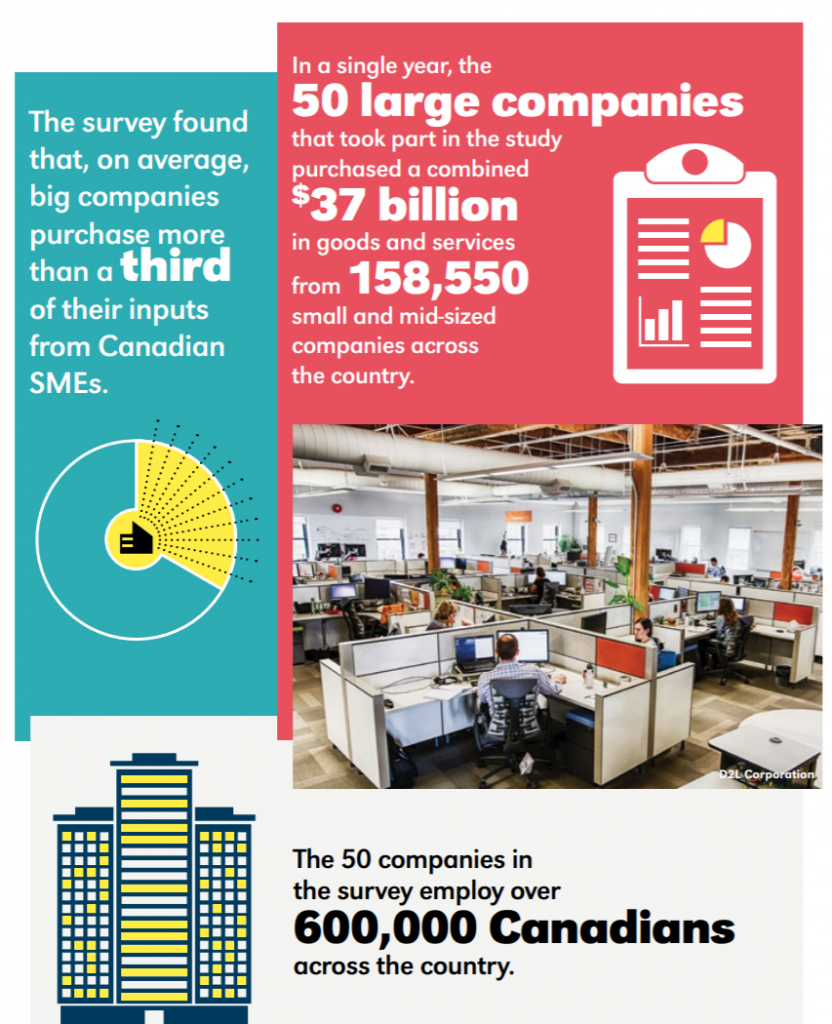

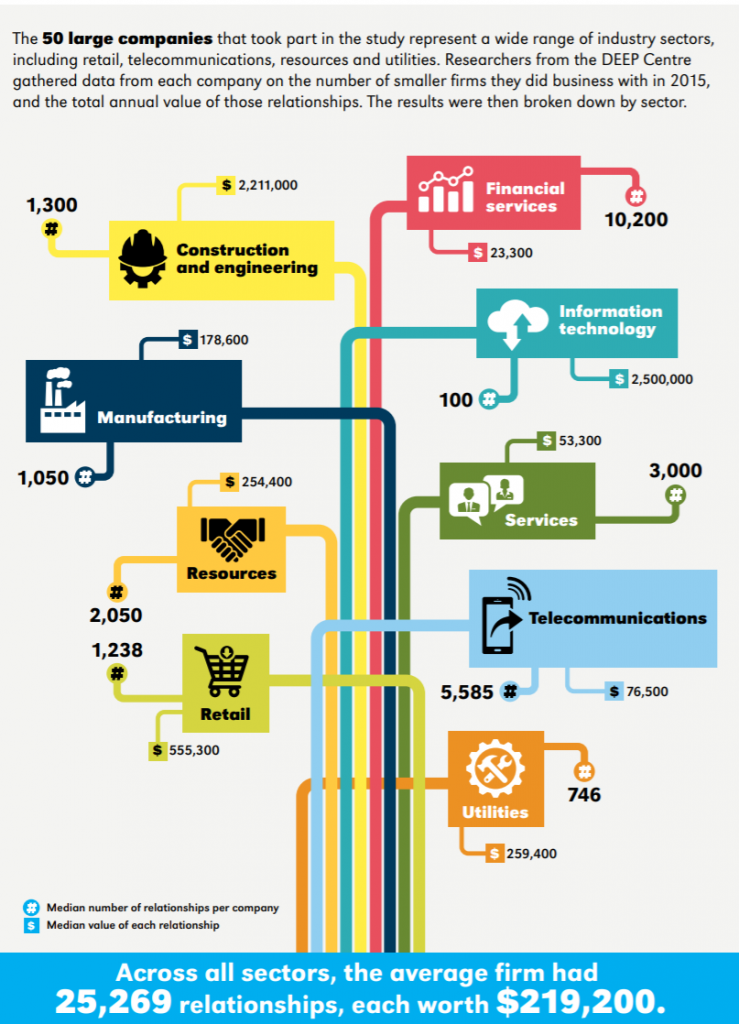


40 Years of Policy Innovation
Forty years ago, a small group of Canadian business leaders laid the foundations for an organization that was to have a significant impact on the country’s public affairs. They created what is today the Business Council of Canada, an association of public-spirited business leaders from every sector of the country and every major industry. Through the Council, they would seek to contribute personally to the development of public policy and the shaping of national priorities.

At the time of its founding, corporations were under fire on several fronts. Some critics claimed that the market system had failed. Others accused the business community of acting only in self-interest. Still others decried the absence of private sector leadership in helping to address the major social and economic issues of the day.
The Council was a response to these challenges. But it was also a positive manifestation of an idea: the belief that corporations and their leaders have a responsibility not only to their shareholders and other traditional constituents, but to society as a whole. Early on, the Council defined its mandate to include a broad range of policy issues, not merely economic ones. Equally important, Council members were expected to consider issues from a national perspective, rather than focusing on the interests of individual companies and sectors.
As it enters its fifth decade, the Business Council of Canada remains committed to these same aims and principles, as a source of thoughtful, constructive advocacy in the national interest.

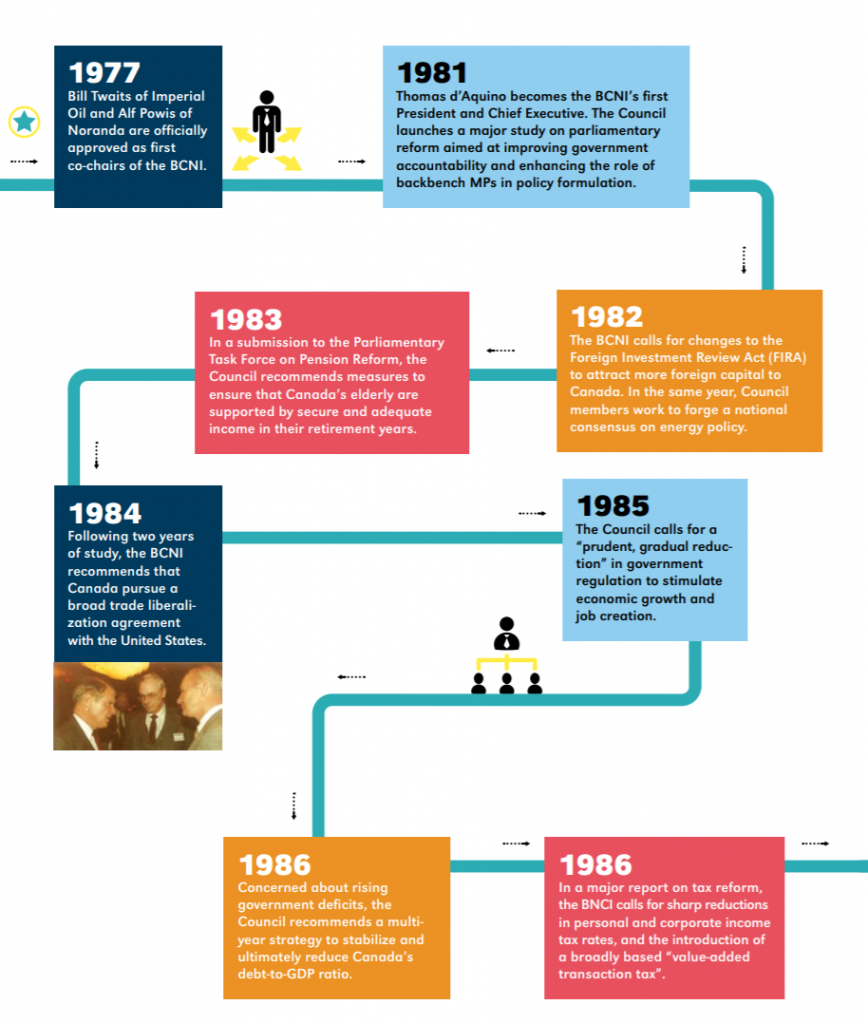
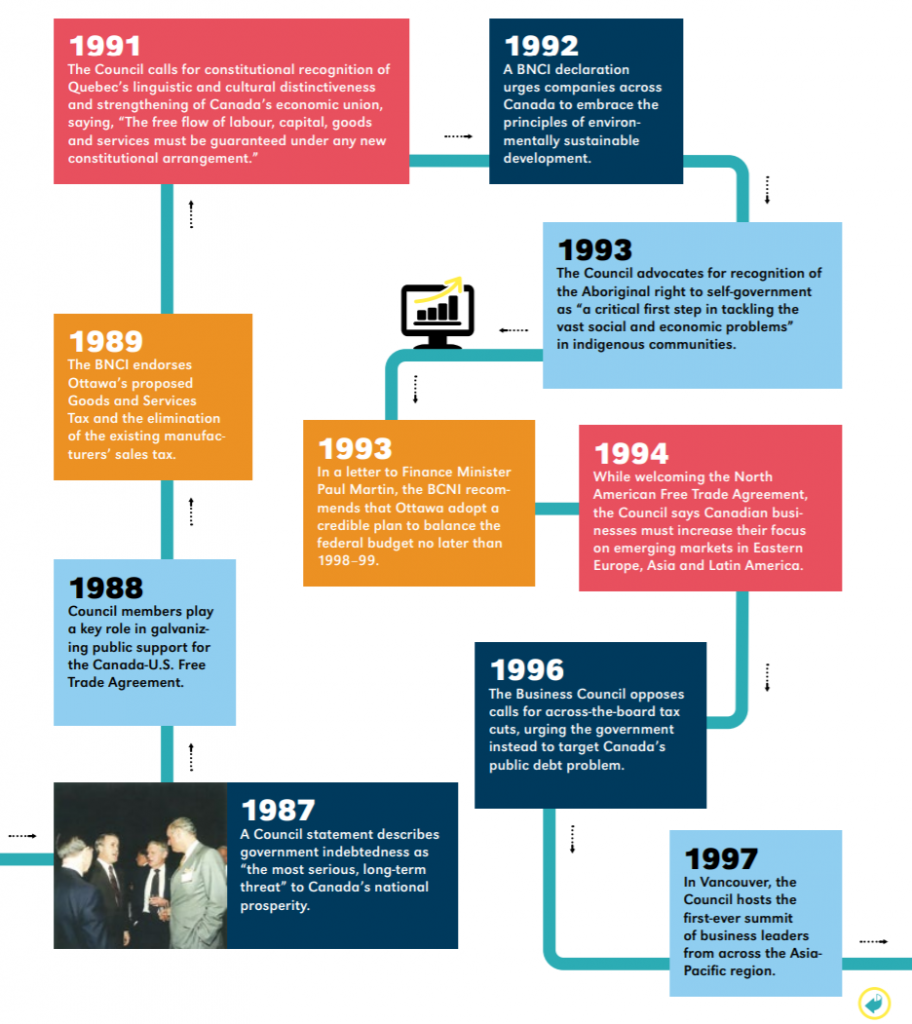



CEO Summits
The full membership of the Business Council of Canada meets three times a year to discuss critical domestic and international issues, the economic outlook, and future trends. These events provide Canada’s business leaders with unique opportunities to exchange views with their counterparts across the business community as well as with senior policymakers, top thinkers and innovators from around the world. Over the past 12 months, the Business Council has hosted members’ meetings in Washington, Montreal and Toronto.
Washington
As the U.S. presidential primary season was beginning to heat up, Business Council members headed to Washington to meet with American lawmakers and underscore the benefits of a strong Canada-U.S. economic and political partnership. Canada’s Ambassador to the United States, The Honourable Gary Doer, welcomed Council members to the capital at a reception at the Canadian Embassy. The next morning, sessions focused on the role of the United States at a time of global disorder, featuring presentations by Thomas Friedman, columnist for The New York Times, and Dr. Nouriel Roubini, former senior economic adviser to President Bill Clinton. At the U.S. Capitol, members met with Senators and Congressional representatives to discuss pressing issues of security, trade and the North American economic environment.
Additional speakers included:
- Jim Messina, architect of President Barack Obama’s re-election campaign,
- The Honorable Ernest J. Moniz, United States Secretary of Energy;
- The Honorable Bruce Heyman, Ambassador of the United States of America to Canada; and
- The Honorable John Engler, President of the Business Roundtable.
Montreal
The Council’s first meeting of 2016 focused on the impact of disruptive innovation in business and everyday life. Jeffrey Immelt, Chairman and Chief Executive Officer of GE, spoke about the digitization of the industrial world and explained why he believes every company is now in the information business – whether it realizes it or not. Prime Minister Justin Trudeau exchanged views with Council members on his government’s economic agenda and emphasized the role of business in creating a prosperous middle class. Perry Bellegarde, National Chief of the Assembly of First Nations, discussed the evolving relationship between the federal government and Canada’s Aboriginal peoples. Meanwhile, the Council recognized the contributions of outgoing Chair Paul Desmarais, Jr. (Power Corporation of Canada), as he passed the baton to Linda Hasenfratz (Linamar Corporation). Council members also toured the newly redesigned headquarters of La Presse, the 130-year-old Montreal paper that has successfully reinvented itself for the digital age.
Toronto
“Leaders must govern not for easy headlines in 10 days but for a better Canada in 10 years – and they must be ready to endure the attacks that often accompany profound or controversial change, while they await the distant and compelling sounds of a verdict that only history and a more
The Right Honourable Brian Mulroney
reflective nation can render in the fullness of time.”
The Spring Members’ Meeting in Toronto kicked off with an evening of reflection and celebration as the Council marked its 40th anniversary. Dominic Barton, Global Managing Director of McKinsey & Company and Chair of the Prime Minister’s Advisory Council on Economic Growth, offered a sweeping presentation on the powerful forces that are reshaping the world’s economy. The next morning, Finance Minister Bill Morneau discussed his first budget and answered members’ questions on tax policy and the economic outlook. Two separate CEO panel discussions examined disruptive innovation in the financial services sector and Canada’s energy industry, with additional perspectives from Don Tapscott, author of “The Blockchain Revolution”, and Salim Ismail, Founding Executive Director of Singularity University. The meeting concluded with an inspiring presentation by The Right Honourable Brian Mulroney on the need for bold and transformative political leadership.








